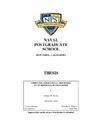IMPROVING OPERATIONAL REPORTING WITH ARTIFICIAL INTELLIGENCE
| dc.contributor.advisor | Das, Arijit | |
| dc.contributor.advisor | Warren, Timothy C. | |
| dc.contributor.author | Bailey, George W. | |
| dc.date.accessioned | 2021-02-23T00:01:33Z | |
| dc.date.available | 2021-02-23T00:01:33Z | |
| dc.date.issued | 2020-12 | |
| dc.identifier.uri | https://hdl.handle.net/10945/66578 | |
| dc.description.abstract | Today, military analysts receive far more information than they can process in the time available for mission planning or decision-making. Operational demands have outpaced the analytical capacity of the Department of Defense. To address this problem, this work applies natural language processing to cluster reports based on the topics they contain, provides automatic text summarizations, and then demonstrates a prototype of a system that uses graph theory to visualize the results. The major findings reveal that the cosine similarity algorithm applied to vector-based models of documents produced statistically significant predictions of document similarity; the Term Frequency-Inverse Document Frequency algorithm improved similarity algorithm performance and produced topic models as document summaries; and a high degree of analytic efficiency was achieved using visualizations based on centrality measures and graph theory. From these results, one can see that clustering reports based on semantic similarity offers substantial advantages over current analytical procedures, which rely on manual reading of individual reports. On this basis, this thesis provides a prototype of a system to improve the utility of operational reporting as well as an analytical framework that can assist in the development of future capabilities for military planning and decision-making. | en_US |
| dc.description.uri | http://archive.org/details/improvingoperati1094566578 | |
| dc.publisher | Monterey, CA; Naval Postgraduate School | en_US |
| dc.rights | This publication is a work of the U.S. Government as defined in Title 17, United States Code, Section 101. Copyright protection is not available for this work in the United States. | en_us |
| dc.title | IMPROVING OPERATIONAL REPORTING WITH ARTIFICIAL INTELLIGENCE | en_US |
| dc.type | Thesis | en_US |
| dc.contributor.department | Defense Analysis (DA) | |
| dc.subject.author | similarity | en_US |
| dc.subject.author | natural language processing | en_US |
| dc.subject.author | NLP | en_US |
| dc.subject.author | machine learning | en_US |
| dc.subject.author | artificial intelligence | en_US |
| dc.subject.author | term frequency | en_US |
| dc.subject.author | inverse document frequency | en_US |
| dc.subject.author | TF-IDF | en_US |
| dc.subject.author | China | en_US |
| dc.subject.author | graph | en_US |
| dc.subject.author | cosine | en_US |
| dc.subject.author | Euclidean | en_US |
| dc.subject.author | Jaccard | en_US |
| dc.description.service | Major, United States Army | en_US |
| etd.thesisdegree.name | Master of Science in Defense Analysis (Irregular Warfare) | en_US |
| etd.thesisdegree.level | Masters | en_US |
| etd.thesisdegree.discipline | Defense Analysis (Irregular Warfare) | en_US |
| etd.thesisdegree.grantor | Naval Postgraduate School | en_US |
| dc.identifier.thesisid | 34405 | |
| dc.description.distributionstatement | Approved for public release. distribution is unlimited | en_US |
| dc.identifier.curriculumcode | 699, Special Operations |
Files in this item
This item appears in the following Collection(s)
-
1. Thesis and Dissertation Collection, all items
Publicly releasable NPS Theses, Dissertations, MBA Professional Reports, Joint Applied Projects, Systems Engineering Project Reports and other NPS degree-earning written works.





